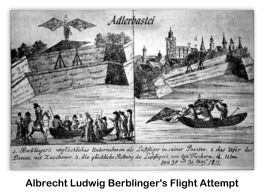

| 1800-1809 | Master Index | 1820-1829 |
1810-1819 Chronology of Aviation History
Major Aviation Events
1810
- No Data
1811
31 May 1811 (Ulm, Germany) — Albrecht Ludwig Berblinger, the “Tailor of Ulm” crashes in his apparatus, a copy of Degen's, into the Danube. It was presumably a workable hang glider.
Berblinger was the seventh child of a poor family. When he was 13 his father died and he was sent to an orphanage. There he was forced to become a tailor although he wanted to become a watchmaker. He became a master craftsman at 21, but he still was interested in mechanics. In his spare time in 1808 he invented the first artificial limb with a joint. His most important invention was a hang glider, which was supposed to let him fly. He worked on it for years, improving it and watching the flight of owls. People made fun of him and he was threatened with exclusion from the guild. He was ordered to pay a large fine for his working outside of the guild. Nevertheless he invested his whole income in his project. King Frederick I of Württemberg became interested in his work and sponsored him with 20 Louis.

He tried to demonstrate that the glider could really fly on the evening of May 30, 1811 in the presence of the king, his three sons and the crown prince of Bavaria. The king and a large number of citizens waited for the flight but Berblinger cancelled it, claiming that his glider was damaged. The next day May 31 he made a second attempt from a higher location - the Adlerbastei (Eagles Bastion). This structure no longer exists but a plaque commemorates it on the banks of the river in Neue Strasse just past the Dreifaltigkeitskirche (Holy Trinity Church). The king had left by this time, but his brother Duke Heinrich and the princes stayed to watch. Berblinger waited so long for a good wind, that a policemen finally gave him a push and Berblinger fell into the Donau (Danube). Other versions of this account have no mention of the policeman and claim that the difference in temperature over the cold Donau (Danube) limited thermal updrafts and therefore the glider failed to lift. He survived and was rescued by fishermen. His reputation was effectively ruined as a result and his work suffered. He was 58 years old when he died in a hospital.
The story of the tailor, who tried to fly, subsequently resulted in some fleer and allusions in publications of the 19th century. When, for instance, Wilhelm Busch drew in his picture story Max and Moritz a tailor falling into a stream, he could count on some awareness of his readers. It took time until the end of the century, when Otto Lilienthal actually could undoubtfully prove the feasibility of a heavier-than-air flight. ²
1812
19 July 1812 (France) — Lamp gas is used to fill a Montgolfière balloon. ²
1813
- No Data
1814
- No Data
1815
- No Data
1816
- No Data
1817
- No Data
1818
- No Data
1819
- No Data
Works Cited
- Wikipedia, Timeline of Aviation — 19th Century
- Wikipedia, Albrecht Berblinger
Copyright © 1998-2018 (Our 20th Year) Skytamer Images, Whittier, California
ALL RIGHTS RESERVED


























